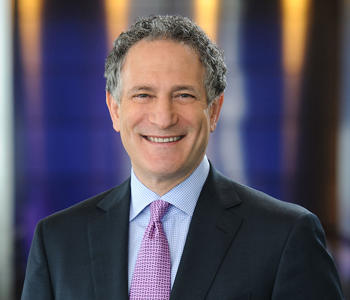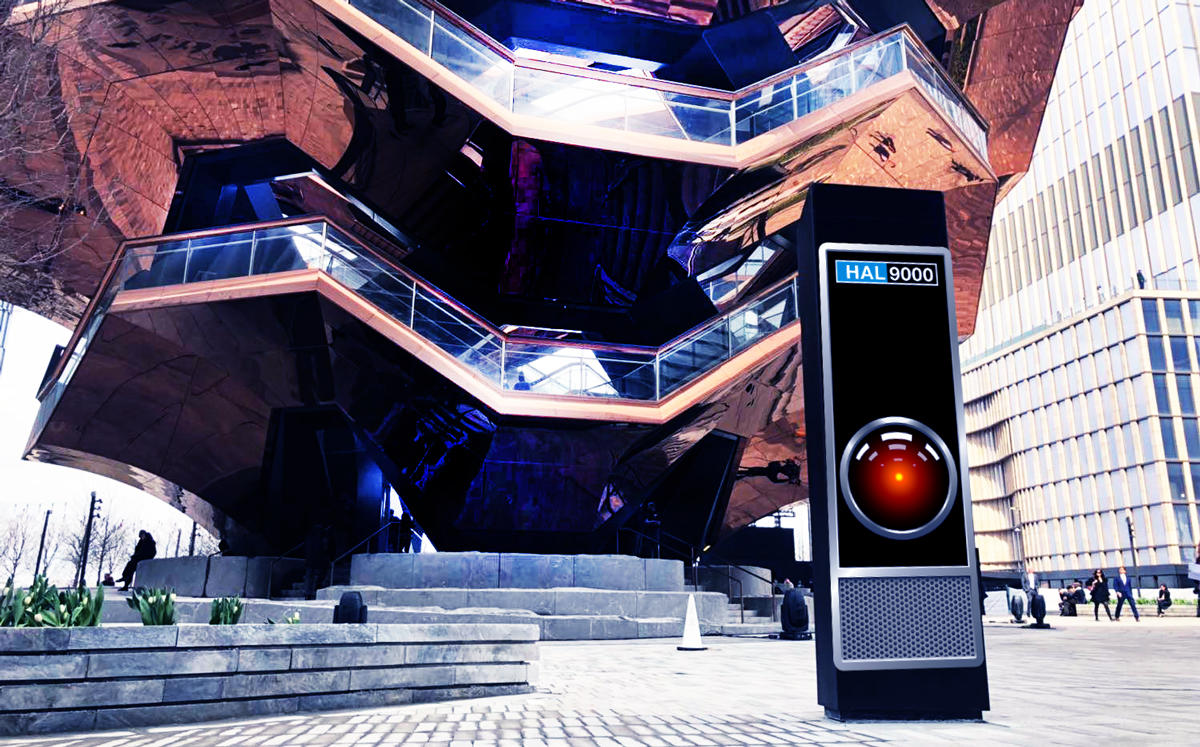In a scene from “Gattaca,” the dystopian 1997 film set in the “not too distant future,” dozens of people are seen entering the Gattaca Aerospace Corporation headquarters using their genetic fingerprint to pass security clearance. It may seem like a far-flung sci-fi reference, but at Hudson Yards, the gargantuan “smart city” that officially opened Friday on the Far West Side, there are elements of art-meets-life.

Related Hudson Yards president Jay Cross (Credit: University of Toronto)
“We said, ‘What should technology be able to do at Hudson Yards if it’s truly a smart city?’’” said Jay Cross, president of Related Hudson Yards, the project’s developer.
Related says its use of technologies will make life better for those who work, live or shop in the 16 buildings planned for the $25 billion development. But the company’s decision to hold user data indefinitely, as well as its partnership with the firm behind the controversial LinkNYC kiosks, has sparked alarm among surveillance and data privacy watchdogs.
Related says it hasn’t yet determined exactly what it will do with data it collects from people in the neighborhood, or movements its cameras record. “But from our point of view, the data is our data for the purposes of allowing us to make Hudson Yards function better,” said Cross.
One example is Related Connect, an app for residents at 15 Hudson Yards that replaces the apartment key with a smart-phone. Another feature is Pass, a system in the office buildings that scans a biometric handprint to allow tenants into the building; their guests are provided access by using a QR code.
The data is our data for the purposes of allowing us to make Hudson Yards function better said Jay Cross
A third technology is a yet-to-be-named “content-management system” which includes 30 kiosks dotted across the 26-acre site. This is the most visible element of Related’s use of technologies for its smart city, and the one that has sparked the greatest concern from data privacy advocates.
Similar in appearance to LinkNYC towers, these 10-foot tall rectangular figures contain interactive touch screens on either side that can be used to book restaurants, buy tickets for “the Vessel” or get directions, and send alerts to your phone.
Less known is the inclusion of two tiny cameras on each side and sensors that track atmosphere levels. Cross said the cameras will be primarily used to relay pedestrian figures to advertisers.
“We can say how many people looked at this ad, for how long. Did they seem interested, bored, were they smiling?” he said.
But they may have other uses, too. For example, they could track pedestrian traffic from the No. 7 subway. This information would then sit in a “data lake” to be used to enhance the experience for people in Hudson Yards, he said.
Though Related doesn’t currently have any plans to sell user information to third-party companies or government entities, Cross said the private developer could do so in the future.
“We can do with what we want with our data; we’re not averse to using it to help the city map the West Side.”
The city said it currently does not have a data-sharing agreement with Related, nor are there any city laws regarding data collection that would apply to the real estate company.
“There are regulations regarding information the government collects, but not private businesses,” city spokesperson Jane Meyer said in a statement.
“Red flags” for privacy advocates
To develop the kiosks, Related hired urban technology firm Intersection. The company, which is owned by a subsidiary of Google’s parent company Alphabet, provides the content management system for the kiosks, and displays the advertisements and news features that appear on the screens.
Intersection has been criticized over data privacy matters before. It’s the company behind the LinkNYC towers, the kiosks that have replaced phone booths across the city and display advertisements, news alerts and provide wifi access.
In 2017, the firm received blowback from data-privacy advocates who learned the towers were storing personal browser history indefinitely and tracking other user data without clear privacy policies in place. The company also initially said the towers “may” contain cameras, before updating its user policy to state that its cameras are active.
Ultimately, Intersection updated its policy for the kiosks and now can only keep footage for seven days. Information including device type, device identifiers — data collected when a person signs onto its Wi-Fi — is now deleted after 60 days. And it no longer stores web addresses.
With the Hudson Yards kiosks, no such limitations exist, and the data will be collected and stored en-masse. Intersection will be privy to any data collected, but will not be allowed to use it for its own purposes, Cross said.
This has created some concern among data privacy and surveillance watchdogs. The New York Civil Liberties Union, which called out LinkNYC for its previously lax privacy policy, said Hudson Yards’ “embrace of manifold data collection” raised concerns.

NYCLU’s Daniel Schwarz (Credit: Twitter)
“Cameras, microphones, Wi-Fi kiosks and other sensors leave visitors vulnerable to exploitative and invasive data collection methods that allow for the precise tracking of people’s identity, movement, interactions, and behavior,” said Daniel Schwarz, a privacy and technology strategist at the NYCLU. “Prior notice and consent should be a baseline requirement.”
Shahid Buttar, a director at the Electronic Frontier Foundation, an international digital privacy advocacy group that campaigned against LinkNYC, said that infinite data retention periods are a “red flag” for data privacy and the rights of individuals who do not opt-in to the technologies — for example, being filmed.
“This kind of technology, absent community control, can be pernicious,” Buttar said. “It might be a private neighborhood, but it’s still no more respectful of the individuals that are in it.”
In response to these concerns, Cross said that mass data collection is not of interest to the developer and that its capabilities to pool data is dwarfed by the scale of LinkNYC’s network of kiosks, which number almost 2,000.
Prior notice and consent should be a baseline requirement. said Daniel Schwarz
“For us it’s about running the campus better, it’s completely different from the world of big data,” he said. “We don’t have enough collection points.”
A lesson in Canada
Intersection’s chairman Dan Doctoroff is considered by many to be the initial mastermind of Hudson Yards — he even came up with the name while serving as deputy mayor of New York City under Michael Bloomberg. Doctoroff also doubles as chairman and CEO of Sidewalk Labs, a “smart city” urban developer that is the majority owner of Intersection and shares an office with the company at 10 Hudson Yards. Sidewalk Labs is owned by Alphabet.

Intersection’s chairman Dan Doctoroff (Credit: Wikipedia)
Doctoroff’s vision for a smart city has evolved through his work on a controversial project he’s spearheaded in Canada. Sidewalk Labs secured a tender to develop a slice of an 800-acre plot of land on the shore of Lake Ontario in 2017. The first neighborhood of the futuristic site, called Quayside, is expected to include heated sidewalks to melt snow, mostly timber buildings, self-driving cars and climate controlled public spaces that can block rain and snow.
But the project has received intense pushback from the local community who claim that Sidewalk Labs subverted the democratic process to win the tender and secure the site. The former Ontario Privacy Commissioner, Ann Cavoukian, who was hired to consult Sidewalk Labs, resigned from the project in October after she deemed it a “smart city of surveillance.” In December, the Ontario Auditor-General issued a scathing report that found the government body that granted Sidewalk Labs the land bypassed standard processes of awarding a tender and gave advanced time to the developer to prepare its application.

BlackBerry’s former co-chief executive Jim Balsillie (Credit: Centre for International Governance Innovation)
“You don’t have an option to opt out of a surveillance city,” said Jim Balsillie, the former co-chief executive of BlackBerry, who has been a vocal opponent of Sidewalk’s operation in Toronto.
In the past month, the project received negative coverage after a business plan leaked to the Toronto Star, outlining Sidewalk Labs’ aim to collect city payments for developing the neighborhood — another disclosure that outraged opponents of the project. Sidewalk Labs did not respond to requests for comment for this story. Intersection declined an interview with Doctoroff and directed inquiries to Related.
(After this article was published, Intersection sent a statement from Chris Gross, its chief operating officer, noting that Intersection does not manage wi-fi at Hudson Yards. “We do not collect data on our own behalf from any Hudson Yards services,” he said.)
Hudson Yards, by comparison, has only elements of the technology expected to be deployed in Toronto. It was first mapped out in 2008 — the year after the iPhone was released — and not built from the ground up with technology in mind. And, unlike Toronto, Hudson Yards is built by a pure-play real estate developer, rather than a technology company.
However, it does have capabilities to advance its technological offerings. The cameras built into the kiosks do not currently have software to enable facial recognition, but are capable of supporting the feature — something Cross said there are no immediate plans for.
But also contained within the kiosks are small microphones that, when activated, will have voice recognition and the ability to talk with pedestrians.
“Eventually you’ll be able to talk to this,” said Cross. “It’ll be like HAL 2001.”
